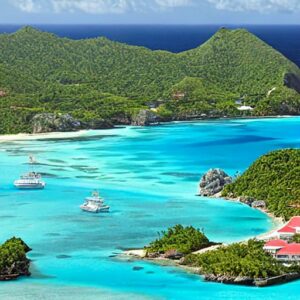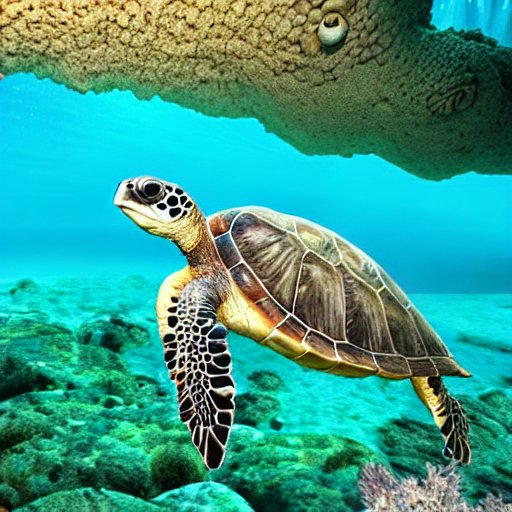As someone who has spent a lot of time exploring the Caribbean, I have always been captivated by the crystal-clear waters and the striking shades of blue that dominate this region.
I’m sure you’ve wondered at some point why the Caribbean water is so clear and blue?
Well, wonder no more!
I am going to take you on a journey to explore the mysteries behind this incredible phenomenon.
Let’s dive right in and answer the burning question: Why is Caribbean water so clear and blue?

I’ll never forget the time I went on a snorkeling trip in the Bahamas.
As soon as I plunged into the water, I was struck by how clear and bright everything was.
I could see all the way to the ocean floor, and the colors of the coral and marine life were so vivid, they almost looked fake.
I later learned that this is not an uncommon experience in the Caribbean.
Did You Know?
The Caribbean Sea is one of the largest seas in the world, covering an area of approximately 2,754,000 square kilometers.
What Makes Caribbean Water So Clear?

The clarity of the water in the Caribbean is due to several factors, including:
- The lack of sedimentation
- The presence of sunlight
- The oceanic currents
The Role of Sedimentation
One of the primary reasons why the Caribbean water is so clear is due to the lack of sedimentation.
Sedimentation is the process of particles in the water sinking to the bottom, which makes the water appear murky or cloudy.
However, the Caribbean Sea has very little sediment, which allows sunlight to penetrate deep into the water and illuminate it with incredible clarity.
The Impact of Sunlight
The Caribbean is located in a region that receives a significant amount of sunlight, which also contributes to the clarity of the water.

The sunlight provides the energy that drives photosynthesis in the algae and other microorganisms that live in the water, which creates a rich source of oxygen and nutrients that support marine life.
The Role of Oceanic Currents
The Caribbean Sea is characterized by strong oceanic currents that help to keep the water moving and prevent stagnation.
These currents also bring in fresh water from other parts of the ocean, which helps to maintain the salinity levels in the water and promote the growth of healthy marine ecosystems.
Why Is Caribbean Water So Blue?

The Caribbean Sea is famous for its striking shades of blue, which are due to a phenomenon known as Rayleigh scattering.
Rayleigh scattering occurs when the sunlight enters the water and is scattered by the molecules in the water, which absorb the longer red, yellow and green wavelengths, leaving only the short blue wavelengths to be reflected back to the surface.
Picture this: the sunlight is just pouring down into the water, ready to create that beautiful underwater world.
But then, it starts hitting these little molecules in the water and scattering everywhere.
Those pesky molecules just suck up all the longer red, yellow, and green wavelengths, leaving only the short blue wavelengths to bounce back up to the surface.
Where Is The Clearest Water In The Caribbean?
The mere mention of this tropical paradise conjures up images of crystal clear waters, pristine beaches, and unforgettable adventures.
As a water enthusiast, I’ve been lucky enough to explore some of the most breathtaking destinations in the Caribbean, and let me tell you, the clarity and color of the water never cease to amaze me.
So, where can you find the clearest water in the Caribbean?
Well, that depends on a few factors, including the location, time of year, and weather conditions.
Here are some of my top picks for the clearest water in the Caribbean:
The Exumas, Bahamas
If you’re looking for picture-perfect turquoise waters that seem to stretch on forever, the Exumas in the Bahamas should be at the top of your list.
This chain of islands boasts some of the clearest water in the Caribbean, with visibility of up to 200 feet.
Imagine swimming alongside schools of tropical fish, spotting colorful coral formations, and feeling like you’re in your very own private paradise.
It’s no wonder that the Exumas are a popular destination for snorkeling, diving, and water sports.
Bonaire
Located in the southern Caribbean, Bonaire is a small island known for its world-class diving and stunning underwater scenery.
The water here is exceptionally clear, with visibility of up to 100 feet, and the coral reefs are teeming with marine life.
Whether you’re a seasoned diver or a beginner, Bonaire is a must-visit destination for anyone who loves to explore the beauty of the ocean.
Virgin Gorda, British Virgin Islands
The British Virgin Islands are home to some of the most picturesque beaches in the Caribbean, but Virgin Gorda stands out for its pristine waters and secluded coves.
The water here is so clear that you can see the colorful fish swimming below the surface, and the boulders and rock formations add a unique element of beauty to this already stunning destination.
Snorkeling, kayaking, and paddleboarding are just a few of the activities that you can enjoy in the clear waters of Virgin Gorda.
Grand Cayman, Cayman Islands
The Cayman Islands are known for their world-renowned diving, and Grand Cayman is no exception.
The water here is incredibly clear, with visibility of up to 100 feet, and the coral reefs are home to a diverse array of marine life.
The famous Stingray City is a must-visit destination for anyone traveling to Grand Cayman, where you can get up close and personal with the friendly stingrays that call the crystal clear waters home.
In conclusion, there are many destinations in the Caribbean that boast clear, blue waters that are perfect for exploring, whether you’re a seasoned diver or a casual swimmer.
From the Exumas and Bonaire to Virgin Gorda and Grand Cayman, the beauty of the Caribbean’s clear water is just waiting to be discovered.
The Clearest Water In The Caribbean – Island Chart
| Island | Benefits of Clear Water |
|---|---|
| Aruba |
|
| Antigua |
|
| Barbados |
|
| Bonaire |
|
| The Cayman Islands |
|
| Curaçao |
|
| The Dominican Republic |
|
| The Grenadines |
|
| Jamaica |
|
| The Virgin Islands |
|
| Bahamas |
|
Sediment, Algae, and Plankton: Uncovering the Causes of Murky Ocean Waters
Now, Let’s talk about one of the ocean’s most mysterious phenomena – murky and brown water.
You know the kind I’m talking about – it looks like a cup of weak coffee, and you can’t see your hand in front of your face when you dive in.
But why is this happening in some parts of the ocean and not others?
Let’s dive into the details and find out.
First of all, let’s talk about sediment.
Sediment is made up of tiny particles of dirt, sand, and other debris that can be carried into the ocean by rivers, wind, and waves.
When sediment is stirred up by storms or currents, it can create a murky, brownish appearance in the water.
So, if you’re in an area with a lot of sediment runoff, you’re more likely to experience murky water.
But sediment isn’t the only culprit.
Algae blooms can also cause the water to turn brown and murky.
Algae blooms occur when there is an excess of nutrients in the water, such as nitrogen and phosphorus.
These nutrients can come from sources like agricultural runoff and sewage.
When there’s too much of them, algae can grow out of control, turning the water brown or green and creating a funky smell.
Another factor that can contribute to murky water is plankton.
Plankton are tiny organisms that float in the water, and they can sometimes create a brownish tint.
However, not all plankton are bad – in fact, some types of plankton, like bioluminescent plankton, can create a beautiful glow in the water at night.
Finally, it’s worth noting that some areas of the ocean are naturally murkier than others.
For example, the Gulf of Mexico is known for its brownish water, which is caused by sediment runoff from the Mississippi River.
The same is true for many coastal areas around the world.
So, there you have it – the reasons why some ocean waters can be murky and brown.
But don’t worry, there are still plenty of places where you can experience crystal clear waters, like the Caribbean or the Maldives.
Just make sure to do your research and avoid areas with high levels of sediment or nutrient runoff.
And, if you’re feeling adventurous, why not take a dive into murky waters and see what kinds of creatures are hiding beneath the surface?
You might just be surprised at what you find.
Why Do We Study Ocean Color?
Ah, the mesmerizing blues and greens of the ocean.
Have you ever wondered why the water appears to change colors?
I sure have!
That’s why I’m diving into the reasons why we study ocean color.
First off, the color of the ocean can reveal a lot about its health and the health of the surrounding ecosystem.
By studying ocean color, we can track changes in the levels of chlorophyll and other important nutrients that are essential for the growth of phytoplankton and other marine life.
In turn, this information can be used to monitor the effects of pollution and climate change on the ocean and its inhabitants.
But it’s not just about the health of the ocean.
Ocean color can also provide insight into larger-scale phenomena, such as the movement of ocean currents and the effects of weather patterns on the ocean.
This information is crucial for understanding the global climate system and predicting changes in the Earth’s climate over time.
As if that weren’t enough, studying ocean color also has practical applications for a variety of industries.
For example, fisheries can use ocean color data to track the movements of fish and other marine life, while the shipping industry can use this information to optimize shipping routes and reduce fuel consumption.
So, why do we study ocean color?
The answer is simple: because it holds the key to understanding and protecting one of the Earth’s most valuable resources – the ocean.
So next time you gaze out at the beautiful blues and greens of the sea, take a moment to appreciate the wealth of information that those colors hold.
FAQs
1. Can you drink Caribbean water?
While the water in the Caribbean may appear crystal clear and inviting, it is not safe to drink.
The water can contain harmful bacteria and parasites that can cause illness.
It is always best to drink bottled water or use a water filtration system if you are traveling to the Caribbean.
2. Are there any harmful creatures in the Caribbean water?
Yes, there are a variety of potentially dangerous creatures that live in the Caribbean water, including jellyfish, sharks, and barracudas.
However, these creatures are not typically aggressive and will not pose a threat to humans unless provoked or threatened.
3. Is it safe to swim in the Caribbean?
Yes, swimming in the Caribbean is generally safe, as long as you take proper precautions and avoid swimming in areas where there are strong currents or dangerous marine life.
It is always a good idea to check with local authorities or tour operators for information on safe swimming areas.
4. Can pollution affect the clarity of Caribbean water?
Yes, pollution can have a significant impact on the clarity of the Caribbean water, particularly in areas where there is heavy boat traffic or coastal development.
It is essential to be mindful of the impact that our actions can have on the environment and take steps to reduce pollution and protect the natural beauty of the Caribbean.
5. How can I best experience the clear blue waters of the Caribbean?
The best way to experience the clear blue waters of the Caribbean is to get out on the water!
Whether you are snorkeling, diving, kayaking, or taking a boat tour, there are countless ways to explore the natural beauty of this incredible region.
Don’t forget to bring your camera to capture the unforgettable colors and scenery!
Exploring the Science of Caribbean Water Clarity: What Makes It So Unique?
The clear blue waters of the Caribbean are a natural wonder that continues to captivate and inspire travelers from around the world.
From the lack of sedimentation and the impact of sunlight to the role of oceanic currents and Rayleigh scattering, there are many factors that contribute to the clarity and color of the water in this region.
Whether you are a seasoned traveler or a first-time visitor, the Caribbean is sure to leave you spellbound with its breathtaking beauty and unforgettable experiences.



